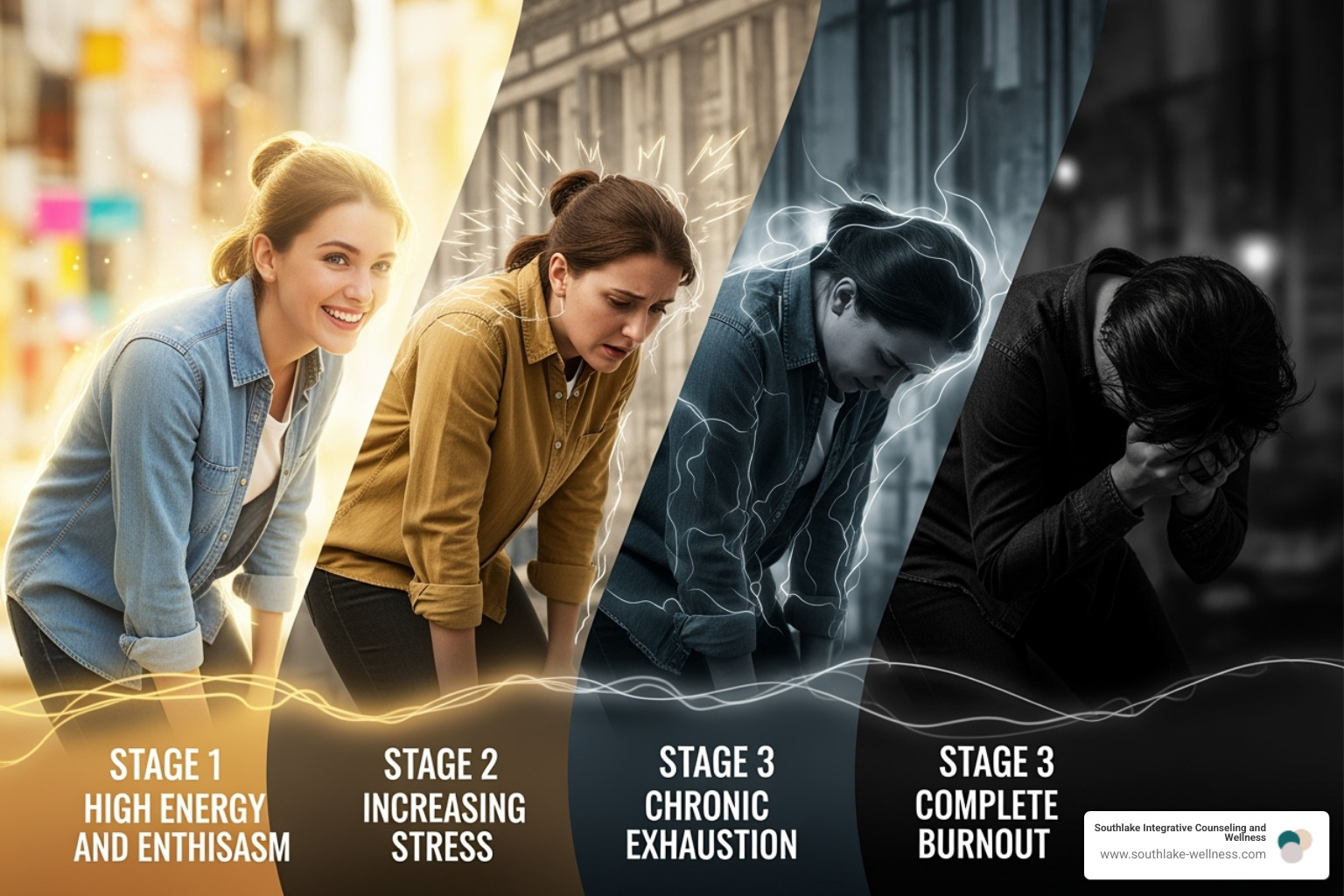
Understanding Burnout: When Stress Becomes Overwhelming
Burnout stress recovery is a critical process for anyone feeling completely drained, cynical about their work, and that nothing they do matters. This is burnout—not just everyday stress. It transforms motivated individuals into emotionally exhausted versions of themselves.
Quick Recovery Overview:
- Recognize the signs - emotional exhaustion, cynicism, and reduced effectiveness
- Address physical needs - prioritize sleep, nutrition, and movement
- Reset emotionally - practice mindfulness and self-compassion
- Set boundaries - learn to say no and redefine success
- Build support - connect with others and consider professional help
- Allow time - recovery typically takes 3 months to a year
Burnout is defined by the World Health Organization as an occupational phenomenon with three core dimensions: emotional and physical exhaustion, cynicism or detachment, and a reduced sense of personal accomplishment. Unlike stress, which involves feeling overwhelmed by "too much," burnout leaves you feeling empty—like you have "not enough" energy, motivation, or hope. Because it develops gradually, burnout can lead to long-term physical and mental health issues if ignored.
I'm Holly Gedwed, a Licensed Professional Counselor Associate with 14 years of clinical experience in trauma, anxiety, and stress. I've helped countless individuals steer burnout stress recovery using evidence-based approaches, understanding that each person's journey back to wellness is unique.

Are You Burned Out? Understanding the Signs and Stages
Burnout doesn't happen overnight; it's a slow leak that gradually drains your energy, motivation, and joy. Burnout stress recovery begins with recognition. Mental health professionals use the "Three R's" approach: Recognize the warning signs, Reverse the damage by seeking support and managing stress, and build Resilience against future burnout.

Burnout manifests in three main ways:
- Physically, you might feel a bone-deep exhaustion that sleep doesn't fix. Look for persistent headaches, muscle tension, changes in appetite or sleep, or getting sick more often.
- Emotionally, life can feel muted. You may notice growing cynicism, feelings of helplessness or defeat, or a sense that nothing you do matters. Things that once excited you may now feel pointless.
- Behaviorally, you might find yourself withdrawing from others, procrastinating, or using food, alcohol, or other substances to cope. These changes often happen so gradually that we don't notice them until they've become a problem.
Researchers have identified 12 stages of burnout development that begin with an intense drive and progress toward unhealthy patterns. Understanding this progression can help you intervene early. As we explore in our guide Can Stress Make You Sick?, chronic stress has real physical consequences.
The Difference Between Stress, Burnout, and Depression
Understanding the differences between stress, burnout, and depression is crucial for effective burnout stress recovery. Stress feels like "too much"—too many demands and too much pressure. You believe that if you could just get control, you'd feel better. Burnout feels like "not enough"—not enough energy, motivation, or hope. It leaves you feeling empty and dried up. Depression is different, casting a wider shadow of pervasive sadness and loss of interest across all areas of life. While burnout is often work-related, depression's negative feelings are more generalized. The research on understanding the burnout experience continues to explore these distinctions.
CharacteristicEveryday StressBurnoutDepressionPrimary FeelingOver-engagement, urgency, hyperactivityDisengagement, helplessness, emotional bluntingGeneral loss of interest, hopelessness, pervasive low moodEmotional StateOverwhelmed, anxious, irritableExhausted, cynical, detached, resentfulSad, empty, numb, irritableMotivationHigh, but overwhelmedLow, lack of driveAbsent, anhedonia (inability to feel pleasure)FocusToo many demandsLack of purpose, sense of inefficacyEverything feels negative, self-blamePhysical SymptomsHeadaches, muscle tension, digestive issuesChronic fatigue, frequent illness, sleep disturbancesChanges in appetite/sleep, aches, low energyRecoveryManage stressors, regain controlRest, re-evaluate priorities, seek meaningProfessional treatment (therapy, medication, lifestyle changes)
The Long-Term Consequences of Unchecked Burnout
Ignoring burnout is like ignoring a warning light in your car; eventually, something will break down. Unchecked burnout has serious consequences.
Your physical health suffers as your immune system weakens, making you vulnerable to illness and increasing the risk for cardiovascular disease and type 2 diabetes. The mental health consequences are equally concerning, significantly increasing your risk for anxiety and depression. The constant exhaustion can lead to feelings of hopelessness that extend beyond work. Our Mental Health Matters guide explores why addressing these concerns early is vital.
Finally, your relationships and performance are impacted. It's hard to show up for loved ones when you're running on empty, and at work, your ability to concentrate and make decisions suffers. The physical and psychological consequences of burnout are well-documented, and recognizing them is often the first step toward recovery.
Your Roadmap for Burnout Stress Recovery
The journey back from burnout requires patience and gentle care. Burnout stress recovery is absolutely possible, and you can reclaim your inner spark. Recovery unfolds in three phases: acknowledgment and acceptance, identifying stressors, and implementing real solutions.
This process isn't about adding more to your to-do list; it's about creating space, setting boundaries, and rebuilding from a foundation of self-compassion. It involves creating distance from what's burning you out and taking action to protect your well-being. We explore various approaches in our guide on Holistic Stress Management Techniques.

Step 1: Heal Your Body with Foundational Lifestyle Changes
When you're burned out, your body is depleted. The first step in burnout stress recovery is to refuel your physical self. Think of this as first aid for your nervous system.
- Prioritize Sleep: Aim for seven to nine hours of quality sleep. Create a consistent, relaxing bedtime routine. Make your bedroom a cool, dark, quiet sanctuary. If your mind races, write down your worries before bed to help your brain let go.
- Nourish Your Body: What you eat directly impacts your energy. Avoid the sugar coaster and focus on steady fuel from whole foods. Stay hydrated. Omega-3 fatty acids from fish or flaxseed can help stabilize your mood. For personalized guidance, consider Functional Nutrition Counseling.
- Move Gently: Forget punishing workouts. Your body needs gentle, rhythmic exercise like a 30-minute walk. Focus on how movement feels, not on calories burned. This mindful approach helps reset your nervous system.
- Reduce Stimulants: Caffeine and nicotine offer temporary energy but contribute to the crash-and-burn cycle. Explore practices that nurture the Mind-Body Connection instead.
Step 2: Reset Emotionally with Mindfulness and Self-Compassion
With your body more stable, you can attend to your emotional world. This phase of burnout stress recovery is about soothing your nervous system and treating yourself with kindness.
- Practice Mindfulness: This isn't about emptying your mind but changing your relationship with your thoughts. Try five minutes of guided meditation, box breathing (inhale-hold-exhale-hold for four counts each), or progressive muscle relaxation to release tension.
- Accept Self-Compassion: This is deeper than self-care. It's about changing your inner dialogue. When the inner critic gets loud, ask, "What would I say to a friend?" Offer yourself that same gentle understanding. You are doing the best you can.
- Journal for Clarity: Use a journal to untangle thoughts without judgment. Write about your day, what you're grateful for, or even write letters you'll never send to release stuck emotions.
- Reconnect with Joy: It's essential medicine. Start small: read a fun book, listen to music, or revisit a hobby you once loved. The goal is pleasure, not productivity. We explore these approaches in our Mindfulness-Based Group Therapy sessions.
Step 3: Reclaim Your Life by Setting Boundaries and Redefining Success
This final step in burnout stress recovery is about taking back control. It's time to honor what matters to you, not just what others expect.
- Set Boundaries: Saying 'no' can feel scary, but saying 'yes' to everything means saying 'no' to your well-being. At work, communicate your workload limits and leave work at work. In your personal life, assess if you have the energy before committing. Declining a request is self-aware, not selfish.
- Question Expectations: Challenge the "shoulds" that run your life. Do you really have to do everything? Evaluate activities based on their return on investment for your energy and well-being. If it doesn't align with your values, consider letting it go.
- Find Meaning: Reignite your sense of purpose. This could be finding value in your work, volunteering, or cultivating passions outside your job.
- Disconnect from Technology: The "always on" culture fuels burnout. Set specific times to check email and social media, and take daily breaks from screens. Limiting social media can reduce feelings of loneliness and depression.
Building Your Resilience and Support System
Burnout stress recovery is not a solo journey. Trying to muscle through alone often prolongs the process. Building a support system is like creating a safety net, giving you the confidence to make the changes necessary for healing.
Social connection is a powerful buffer against burnout. When we feel supported, our nervous system can shift out of high alert, allowing our bodies and minds to recover.

The Role of Professional Help in Burnout Stress Recovery
Sometimes, we need more than friends and family. Professional guidance can accelerate your burnout stress recovery. A licensed therapist offers an objective perspective, helping you identify root causes like perfectionism or people-pleasing patterns.
Cognitive Behavioral Therapy (CBT) is highly effective, helping you challenge thought patterns that fuel exhaustion. Therapy also provides a safe space to process the complex emotions of burnout—anger, grief, and fear. Our Anxiety Therapy approach addresses both burnout symptoms and the underlying anxiety that often accompanies them.
A Southlake therapist can teach you evidence-based coping strategies custom to your situation. Our Evidence-Based Therapy Techniques guide explores various effective approaches. It's also important to rule out other conditions, as burnout can be complicated by medical issues like thyroid problems or depression.
Leveraging Your Social Circle for Support
Your friends and family can be powerful allies, but you must let them in. Isolation makes burnout worse.
- Communicate Your Needs: Let your closest people know you're going through a difficult time. Most want to help but don't know how.
- Ask for Specific Help: Instead of saying "I'm struggling," try "Could you watch the kids for a few hours so I can rest?" Clear requests are easier to fulfill.
- Nurture Connections: Even small steps matter. Have coffee with a coworker or text an old friend. The goal is to nurture connections that energize you.
- Limit Negative Contact: It's okay to minimize time with people who drain your energy while you're healing.
Research on the importance of social support shows that strong social connections improve health outcomes. If relationships are strained, our Family Therapy Guide offers insights.
How Workplaces Can Prevent Burnout
While individual strategies are key, many burnout cases are rooted in workplace culture. Healthy workplaces share common traits:
- Managerial Support: Good managers check in, provide clear feedback, and model healthy boundaries.
- Reasonable Workload: Expectations are realistic and sustainable.
- Recognition and Reward: People feel valued for their contributions through thanks, acknowledgment, or development opportunities.
- Employee Autonomy: Having control over how work is done reduces stress.
- Clear Expectations: Employees understand their roles and performance standards.
- Positive Culture: A culture of psychological safety allows people to express concerns without fear.
Not all workplaces will change. Sometimes, burnout stress recovery involves making difficult decisions about whether your work environment supports your long-term well-being.
Frequently Asked Questions about Burnout Recovery
It's normal to have questions about burnout stress recovery. It's a complex process, and everyone's experience is unique. Here are answers to some common concerns.
How long does it take to recover from burnout?
There's no predictable timeline. Full recovery typically takes anywhere from three months to a year, though some people need longer. You didn't burn out overnight, and you won't recover overnight either. Your nervous system needs time to reset.
Factors like the severity of your burnout, your support system, and your willingness to make real changes will influence your recovery speed. Recovery isn't a straight line. You'll have good days and bad days; this is a normal part of the healing process.
Is burnout a recognized medical condition?
This is a bit complicated. The World Health Organization recognizes burnout as an "occupational phenomenon" resulting from unmanaged workplace stress. However, they specify it is not classified as a medical condition. You can read the WHO's classification of burnout for details.
Similarly, the DSM-5 (the manual used by U.S. mental health professionals) does not list burnout as a distinct disorder. Even so, it is a serious condition that deserves treatment. Think of it like chronic stress: it may not be a "disease," but it can make you sick and is a risk factor for other health conditions if left untreated.
Can you fully recover from burnout and prevent it from happening again?
Yes, absolutely. Full recovery is not only possible but is the norm for those who commit to the healing process. The goal of burnout stress recovery isn't just to feel "okay" again; it's to build a more sustainable, meaningful, and resilient life.
Full recovery means developing a deeper understanding of your limits, recognizing early warning signs, and having the tools to address stress before it becomes overwhelming. Many people feel happier post-recovery because they've learned to align their lives with their true values.
Preventing future burnout involves maintaining healthy lifestyle changes, setting boundaries, and practicing mindfulness. You develop a "stress radar" that helps you take action immediately. Building resilience is about psychological flexibility, self-compassion, and strong support systems. Once you've made this journey, you'll have the wisdom to protect your energy and well-being for good.
Reclaim Your Energy and Thrive
Your journey through burnout stress recovery begins with taking action. We've walked through the signs, the causes, and a recovery plan. Now, it's time to accept the hope that full recovery brings.
Burnout isn't a character flaw; it's a signal from your body and mind that it's time to prioritize your well-being. Recovery is a process, and every small step matters. The key is to maintain foundational changes: prioritizing sleep and nutrition, setting healthy boundaries, and practicing self-compassion.
The three-step approach—healing your body, resetting emotionally, and reclaiming your life—addresses burnout holistically. Building a support system is equally crucial. You don't have to recover alone; connection accelerates healing.
At Southlake Integrative Counseling and Wellness, we understand that burnout stress recovery requires more than talk therapy. Our approach emphasizes the mind-body connection. We offer Personalized Mental Health Care that combines evidence-based therapies with holistic modalities, creating treatment plans as unique as you are.
The timeline for recovery varies, but every boundary you set and every mindful breath you take is a building block toward renewed vitality.
If you recognize yourself in these pages, know that seeking help is a sign of strength. Take the first courageous step toward healing by exploring individual therapy in Southlake, TX. We're here to guide you back to feeling energetic, purposeful, and truly alive.